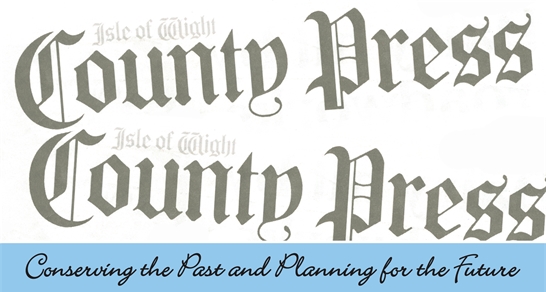September 2023
Concrete Housing
On the Island we have the first concrete housing built in Victorian Times. These are an unassuming pair of semi-detached houses on the main road, near the entrance to Osborne House, in East Cowes. Once there were two pairs, but the second pair was severely damaged in 1942 when a bomb landed nearby.

The concrete houses were constructed of the new Medina Cement, developed at the Stag Lane Cement works on the River Medina in the 1840s. The Romans had made the first cement, which is made from a mixture of lime and clay. The first patent in Britain for ‘Roman’ cement was in 1796. By 1830 firms around the Medway in Kent were making cement. They called it Portland cement, as when set it looked like Portland stone.

Portland Cement Barge on the River Medina
On the west bank of the Medina, similar pioneering cement was being produced in the 1840s. Calling it Medina Cement, this had quick setting properties. One part of cement could be mixed with six parts of washed gravel, making concrete. This was useful for building structures in the sea. Wooden planking, called shuttering, made a former, into which the concrete was poured. Within four hours the concrete was set, which was very useful in tidal conditions. Medina Dock at West Cowes was completed using this concrete in 1846, and a two hundred foot groyne was made in 1851 at Sandown Bay.
The manager of the East Cowes Botanic Gardens development, Richard Langley, had the Concrete Houses constructed in 1852. The development, called ‘East Cowes Park,’ was designed around a triangle of wide roads, which still form the main road structure today. This was once a private gated community of large expensive houses, the gates keeping out the lower classes of society - unless they were delivering goods! Just a few of the stone built mansions still exist, such as Powys House. One pair of the Concrete Houses, at the top of York Avenue, remains.

Concrete houses on the bend opposite Arthur Cottage in 1908
The concrete houses were built using the shuttering system for their external walls. The walls are between 12 and 14 inches thick, (30 cm.) The mouldings around the doors and windows are all of concrete. Even the chimneys were of concrete, sadly dismantled in 1980. It was felt in 1852 that the concrete house would be more durable than brick, and certainly these buildings have lasted well – a lot longer than those of Raac!
The proprietor of the Medina Cement Works, A J Francis, wrote about Cement making history up until 1914. They had exhibited their Medina Cement at the Great Exhibition of 1851. 26 companies, including Medina Cement, amalgamated in 1900, to form Associated Portland Cement Manufacturies. The Medina works stopped manufacturing in 1946.
The office of the Cement Mills, near the railway line, may have been the first experiment with such shuttered walls, but Francis says that it was not until the 1860s that houses were constructed in situ. He had obviously forgotten the East Cowes houses.
So here on the Island we have the earliest known shuttered concrete homes in Britain, and so probably in the world! To find out more, visit Isle of Wight History Centre online, and look at the Cement Mills information board along the Cowes to Newport cycle way.
[Go Back]

